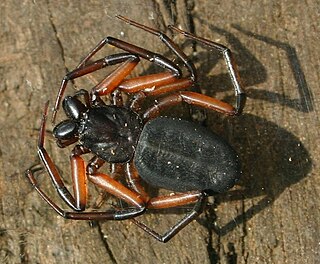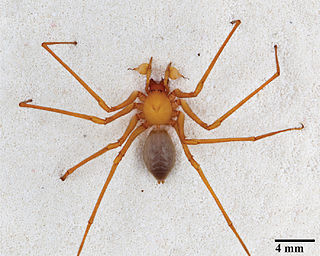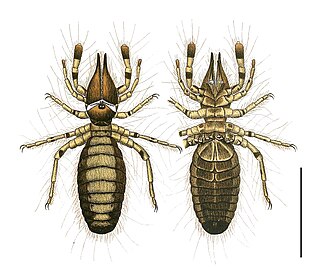
Arachnida is a class of joint-legged invertebrate animals (arthropods), in the subphylum Chelicerata. Arachnida includes, among others, spiders, scorpions, ticks, mites, pseudoscorpions, harvestmen, camel spiders, whip spiders and vinegaroons.

Pedipalps are the second pair of appendages of chelicerates – a group of arthropods including spiders, scorpions, horseshoe crabs, and sea spiders. The pedipalps are lateral to the chelicerae ("jaws") and anterior to the first pair of walking legs.
Syndaesia mastix is a species of arachnids in the order Solifugae, and the only member of the genus Syndaesia. It lives in western Argentina, and is one of only two daesiids in South America, the other being Ammotrechelis goetschi from the Atacama Desert; all other South American solifugids are in the families Eremobatidae and Ammotrechidae.

Eremobates is a genus of arachnids of the order Solifugae. About 2 inches long, these fast-moving arachnids have the largest jaw size to body ratio of any animal. They are not venomous, but have a remarkably powerful bite. Often hunting at night, they have poor eyesight and navigate mostly by use of a pair of pedipalps.

Solifugae is an order of animals in the class Arachnida known variously as camel spiders, wind scorpions, sun spiders, or solifuges. The order includes more than 1,000 described species in about 147 genera. Despite the common names, they are neither true scorpions, nor true spiders. Most species of Solifugae live in dry climates and feed opportunistically on ground-dwelling arthropods and other small animals. The largest species grow to a length of 12–15 cm (5–6 in), including legs. A number of urban legends exaggerate the size and speed of the Solifugae, and their potential danger to humans, which is negligible.

Ammotrechidae is a family of solifuges distributed in the Americas and the Caribbean Islands. It includes 26 described genera and 95 species. Members of this family can be distinguished from members of other families by the absence of claws on tarsi of leg I, tarsal segmentation 1-2-2-(2-4), pedipalps with pairs of lateroventral spines, and by males having an immovable flagellum on the mesal face of each chelicerum. The propeltidium of the Ammotrechidae is recurved.

Poecilotheria is a genus of tarantulas native to India and Sri Lanka. It was first described by Eugène Louis Simon in 1885. They are arboreal tarantulas, commonly known as ornamental tarantulas, known for their vivid color patterns, fast movement, and potent venom compared to other tarantulas. As of 2019 all species are protected under CITES.

Platyoides is a genus of spiders belonging to the family Trochanteriidae. Its members are known as scorpion spiders and are found in sub-Saharan Africa and its islands, Madagascar, Réunion, Aldabra and the Canary Islands.

Trogloraptor is a genus of large spiders found in the caves of southwestern Oregon. It is the sole genus in the family Trogloraptoridae, and includes only one species, Trogloraptor marchingtoni. These spiders are predominantly yellow-brown in color with a maximum leg span of 3 in (7.6 cm). They are remarkable for having hook-like claws on the raptorial last segments of their legs.

Malleolus (plural: malleoli) is a fan-shaped chemoreceptor or racquet organ, an array of which are carried in pairs on the ventral or undersides of Solpugidae. They are the counterpart of pectines in scorpions, and modified walking limbs in the uropygids and amblypygids as well as the pedipalps in spiders and other arachnids. Most species have 5 pairs of malleoli on the ventral surface of the fourth pair of legs of both sexes, while juveniles and other species have 2-3 pairs.
In most animals the central pathways of olfactory systems are associated with glomerular neuropil and lack topographic mapping of sensory inputs. Among arthropods, the insect and crustacean olfactory (antennal) pathways are typical examples. Two orders of chelicerate arthropods, the scorpions and solpugids (Cl. Arachnida), present striking exceptions to this generalization. The major chemosensory organs of scorpions are the pectines, two ventral appendages that contact the substrate intermittently as the animal searches for food or mates. In solpugids chemosensory input is from the antennalized pedipalps and first leg pairs, and from ten fan-shaped malleoli extending ventrally to the substrate from the 4th leg pair. The pectinal and malleolar sensory systems have highly ordered arrangement of 105 to 106 primary chemoreceptors, with one (pectines) forming a two-dimensional array and the other (malleoli) assembled in a linear array. The spatial frequencies of these chemoreceptive inputs exceed 100/mm and 1000/mm, respectively, indicating a capacity for resolving structure of chemical deposits on substrates. Using several histological and axonal tracing techniques, the organization of pectinal and malleolar central projections has been resolved. The pectinal projection terminates posteriorly in the cephalothoracic mass and shows a high degree of topographic precision, perhaps to the level of individual receptors in the sensory field. This chemosensory 'map' is imposed on laminar cytoarchitecture posteriorly in the brain but merges anteriorly into glomerular substructures. The sensory projection from the malleoli shows less topographic order with fewer and larger glomeruli reminiscent of the insect olfactory system. These comparisons between arthropod taxa suggest that olfactory projections are, to varying degrees, typically glomerular but may evolve topographic and laminar organization when the stimulus field is of fixed form.
Eremochelis is a genus of Eremobatid camel spiders, first described by Carl Friedrich Roewer in 1934.
Eremothera is a genus of Eremobatid camel spiders, first described by Martin Hammond Muma in 1951.
Horribates is a genus of Eremobatid camel spiders, first described by Martin Hammond Muma in 1962.

Hemerotrecha is a genus of Eremobatid camel spiders, first described by Nathan Banks in 1903.
Eremobates polhemusi is a species of Solifugae in the family Eremobatidae. It is endemic to Utah, United States.
Sedna is a monotypic genus of ammotrechid camel spiders, first described by Martin Hammond Muma in 1971. Its single species, Sedna pirata is distributed in Chile.
Branchia is a genus of ammotrechid camel spiders, first described by Martin Hammond Muma in 1951.
Ammotrecha is a genus of ammotrechid camel spiders, first described by Nathan Banks in 1900.
Eremorhax is a genus of Eremobatid camel spiders, first described by Carl Friedrich Roewer in 1934.









